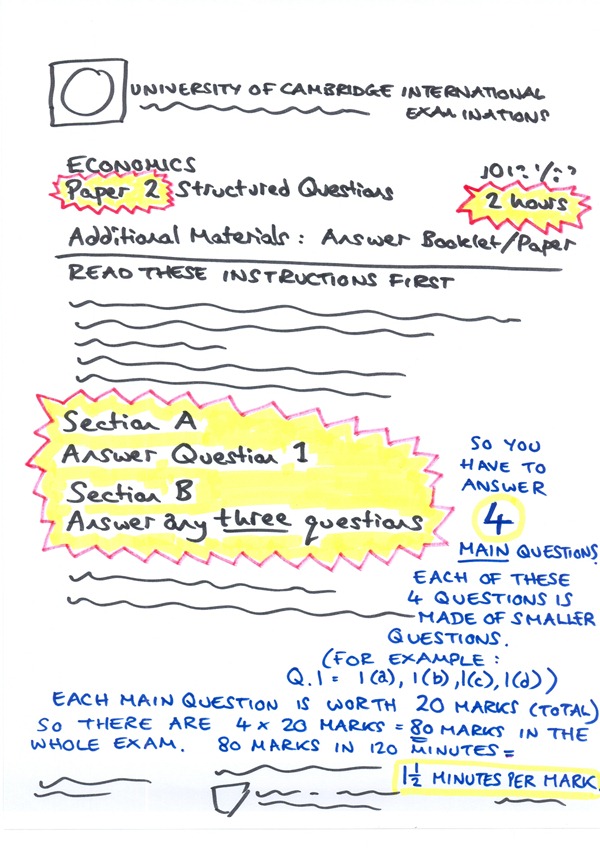
How Long Should You Spend On the IGCSE Economics Paper 2 Questions?
Mar 8th
A very important key to exam success is to get the timings right.
Timings can go wrong in two ways:
- You spend far too little on all questions and have time to spare at the end. If you spend a lot of time doing nothing in your exam, this has a serious ‘opportunity cost’ …
- You take too long on earlier questions, so you don’t leave enough time at the end for later questions and lose valuable marks on these.
You need to use the clock (and a bit of quick mental maths) to your advantage.

Image: Some rights reserved by bastique
Timings
Paper 2 lasts 2 hours.
You have 4 main questions to answer.
You really should stick to 30 minutes per main question.
Each main question is worth 20 marks and is made up of smaller questions. Look at the example below from the specimen paper:
Source: University of Cambridge International Examinations – IGCSE Economics Site
Direct link to specimen paper here
Very important: Section B has 6 main questions to choose from but you only answer 3 of them (giving a total of 60 marks for section B).
You must also answer Question 1 in Section A (worth 20 marks).
The graphic below is a mock up of what the front page of the exam looks like. Check the specimen paper (or any other paper such as the past paper also hosted on the website given above). This graphic highlights the key bits for timings and the words in blue help explain why each mark has one and a half (1.5) minutes for you to spend on it.
You should get in the habit of seeing how many marks a question is worth and then quickly calculating how many minutes you should spend on it. Keep an eye on the clock.
So a smaller 6 mark question deserves 9 minutes of exam time.
Please note that 1 and a half minutes per mark includes reading and checking time.
The shorter 2 or 3 mark questions probably will not need the full 3 or 4.5 minutes. These are often definition questions. They might only take one minute to answer, so you ‘save’ something like two minutes from these questions for your overall reading and checking.
The longer questions 4, 6, 8 or 10 marks (for example) should get their full time from you. So aim to spend a full 6 minutes on a four mark question, etc.
At the very least, stick to timings for the main questions:
Each main question (worth 20 marks each in total) deserves a full 30 minutes from you – no more and no less.
The best way to get all of this is simply to practice past paper questions as often as you can while sticking to the timings. If you do this, you’ll soon get a fell of how much you should be writing on different length questions.

The World’s Most Typical Person
Mar 7th
The world’s most typical person is male and in terms of the mode average ethnic group, is a Chinese, Han man. His age, in terms of median average is 28. The typical face shown above is built of 190 000 photos of 28 year old ethnic Han men. But as the video tells us, he won’t be the most typical person for long …
As World Population approaches 7 billion, NationalGeographic have created a brilliant infographic-style animation, complete with catchy tune and thought-provoking statistics. (There’s also a healthy qualifier in there – “typical is always relative”).
A great starter for population studies or even for discussions about global inequality, like the World Scaled Down to A Village of 100 idea. It might also have value in Theory Of Knowledge discussions of data and what we mean by ‘typical’ and ‘ethnicity’. There’s even a bit relevant to the economic concept of ‘needs and wants’ at the very end.
Packed full of cross-curricular uses, it is simply a ‘must see’.
Price Discrimination
Feb 28th
The first video in this post goes to a student. Komilla (CuteChadz)has produced a very professional looking summary and it is well worth a look:
pajholden does price discrimination
richardmckenzie gives us two videos:
Click here to see a Reffonomics interactive presentation on price discrimination.
For a bit of fun, view the scene from the Monty Python film ‘Life of Brian’ where confusing haggling (first price discrimnation) takes place – click here.
Oligopoly
Feb 21st
IB Syllabus requirements:
• Assumptions of the model
• Collusive and non-collusive oligopoly
• Cartels
• Kinked demand curve as one model to describe interdependent behaviour
• Importance of non-price competition
• Theory of contestable markets
BrynJonesOnline introduces the theory before moving onto Kinked Demand Theory:
Cartels
This helpful video is by richardmckenzie
Non Collusion – Kinked Demand Theory:
An animated slideshow on oligopoly focuses on kinked demand theory (from the excellent Reffonomics ).
The above introduces the ‘kink’ (by ACDCLeadership). The below is by pajholden and goes into more detail:
kinked demand curve theory (click on the link to view)
The kinked demand theory can be extended to show how such a non-collusive oligopolistic firm makes a loss, makes a profit or breaks even (again from the excellent Reffonomics ).
Theory of Contestable Markets
pajholden discusses the theory in his back garden: contestable market theory
economicslessons has produced this video geared towards A Level economics (so the example question at the end is not an IB one):
Extra:
On the interdependency of firms, we should consider John Nash who arrived at the theory of a Nash Equilibrium in which members of a group would serve their own interests by also serving the rest of the group’s interests (as opposed to Adam Smith’s contention that individuals (or firms) will strive to serve their own interests only). This idea was captured in the excellent film A Beautiful Mind and the relevant excerpt can be seen by clicking here.
On the difficulty of drawing a line between monopolistic competition and oligopoly, view this slideshow by Reffonomics.
Finally, for a bit of fun, see how a famous condom manufacturer has approached non-price competition through the power of advertising by clicking here.
Developed and Developing Economies – Online Resources and Revision Materials
Feb 21st
The full title of this section from the IGCSE syllabus is:
‘Developed and developing economies: trends in production, population and living standards’

Image: Some rights reserved by souravdas
Here is what the syllabus requires of us:
Candidates should be able to:
• describe why some countries are classified as developed and others are not;
• recognise and discuss policies to alleviate poverty;
• describe the factors that affect population growth (birth rate, death rate, fertility rate, net migration) and discuss reasons for the different rates of growth in different countries;
• analyse the problems and consequences of these population changes for countries at different stages of development;
• describe the effects of changing size and structure of population on an economy;
• discuss differences in living standards within countries and between countries, both developed and
developing.
![]() There is a lot of overlap between this section of IGCSE Economics syllabus and the Geography (I)GCSE – if you are studying that subject, you will be able to use some of your Geography notes and resources too. Some of the websites given below are Geography revision pages.
There is a lot of overlap between this section of IGCSE Economics syllabus and the Geography (I)GCSE – if you are studying that subject, you will be able to use some of your Geography notes and resources too. Some of the websites given below are Geography revision pages.

Some rights reserved by godwin d
a) describe why some countries are classified as developed and others are not;
Quite a detailed, interactive site: http://bbc.in/hZmNJh
Note: development is bigger than economci growth. Think of economic growth as a key ingredient of development, a sub set of development. This video by geographyalltheway shows us that development can mean a lot of things:
b) recognise and discuss policies to alleviate poverty;
Aid
Fair Trade
mobiuslive posted an excerpt video from eq.tv on fair trade:
And DiagramConsultores gives us this video on Fair Trade in the Domincan Republic:
Microfinance
Video from Opportunity International:
WorldBank provides an example from Mauritania:
c) describe the factors that affect population growth (birth rate, death rate, fertility rate, net migration)

Image: Some rights reserved by Aidan Jones
d) discuss reasons for the different rates of growth in different countries;
e) analyse the problems and consequences of these population changes for countries at different stages of development;
cheergalsal offers this summary of the Demographic Transition Model:
And geographyalltheway gives us this animated explanation:
http://bbc.in/htA601– and follow the links to the pages that follow this first one
Test your understanding here: http://bit.ly/g9Spcs
f) describe the effects of changing size and structure of population on an economy;
g) discuss differences in living standards within countries and between countries, both developed and developing.

Source: http://www.mint.com/blog/trends/mint-map-global-wealth-distribution/

Monopolistic Competition
Feb 8th
Here is the IB syllabus requirement for this sub-topic:
Monopolistic competition
• Assumptions of the model
• Short-run and long-run equilibrium
• Product differentiation
• Efficiency in monopolistic competition
From www.reffonomics.com a useful introductory slide on calculating price and quantity under monopolistic competition scenario:
Which then leads to finding profit (from the same site, www.reffonomics.com) :
One that is earning a loss:
And one breaking even:
You can access all the resources here: Microeconomics by Dick Brunelle and Steven Reff – full credit to these industrious authors of the presentations above.
From http://highered.mcgraw-hill.com (McConnell Brue Economics) we have a useful interactive graph to explore with appropriate questions to solve – click on the image or title below
Now some video resources:
econsteve12 has given us three parts:
pajholden provides this video: click here
richardmckenzie offers this video:
And finally here is ACDCLeadership’s 60 seconds’ worth:
Development Economics TED Talks
Feb 4th
Here is a selection of TED talk videos which should help when studying Development Economics, and help to provide fresh and sometimes unusual perspectives on the topic. A suggested way of making use of these for your studies is to watch an entire video and summarise its key points in 100 words or under. This is no easy task as there will be lots to say, so you have to select what you think were the key / most interesting points. It is also good to include example detail (regions / countries / place names, dates, and figures) as good examples always help to boost your understanding of development.

Monopoly
Feb 1st
The IB syllabus requirements for this sub-topic are to understand:
- Assumptions of the model
- Sources of monopoly power/barriers to entry
- Natural monopoly
- Demand curve facing the monopolist
- Profit-maximizing level of output
- Advantages and disadvantages of monopoly in comparison with perfect competition
- Efficiency in monopoly
Here are a selection of useful resources to further your understanding of the above.
Two very good presentations on monopolies courtesy of http://www.reffonomics.com:
Above Video Source: mjmfoodie

Perfect Competition
Jan 25th
The IB Economics syllabus requires you to understand the following:
• Assumptions of the model
• Demand curve facing the industry and the firm in perfect competition
• Profit-maximizing level of output and price in the short-run and long-run
• The possibility of abnormal profits/losses in the short-run and normal profits in the long-run
• Shut-down price, break-even price
• Definitions of allocative and productive (technical) efficiency
• Efficiency in perfect competition
This selection of resources is designed to compliment your learning of this topic, with a focus on video clips and interactive resources.
Via: http://www.reffonomics.com
This is a very good interactive diagram to try out different scenarios buy adjusting the D=AR=MR line and/or the quantity produced.
Excellent interactive exploration of the relevant theory with multiple choice quiz questions to test your understanding(click on the image)
Via http://openmultimedia.ie.edu created by Javier Carrillo
mjmfoodie on Perfect Competition:
pajholden on equilibrium in perfect competition (click here to view)
richardmckenzie offers two detailed videos:
ACDCLeadership does his usual 60 seconds take on things:

Understanding the Balance of Payments
Jan 25th
This can be a difficult concept to understand (especially at IGCSE level, less so at IB level), mainly because we are trying to understand how an entire country manages its financial accounts of all transactions between itself and other countries. The real difficulty, i find, is that different nations take different approaches which means that there is no uniform ‘model’ of what Balance of Payments should be structured. In some cases, different phrases are used for the same thing (always a source of frustration to students when learning something first time round). Text books and online articles (try this and here) have plenty to say about it, but here are a few resources designed to help simplify understanding.
Here is a skeleton outline of the B of P, which is perhaps oversimplified. A student in my class typed notes from my whiteboard scrawl (thanks Jonathan):
This youtube video by pajholden helps understand the Current Account structure from a UK perspective: ‘balance of payments – structure of the current account ‘
Below, this simple interactive drag and drop exercise hosted at www.reffonomics.com is a useful reminder of how different ‘components’ of the Balance of Payments can be classified. Click on the table / image below.
Below, there is another really helpful interactive exercise by Rafael Pampillon hosted at http://openmultimedia.ie.edu to play around with the different components of the Balance of Payments, where they might be placed and how they might be applied. You are advised to read the guide attached to the .swf file (top right hand corner) but even if time does not allow for this, it is good to experiment as the feedback will help you realise the correct answers with a bit of trial and error). Click on the image below to access the page.
Finally, here is a bit more detail from http://tutor2u.net on the topic (better for IB level than IGCSE level):
http://tutor2u.net/economics/revision-notes/as-macro-balance-of-payments.html

















